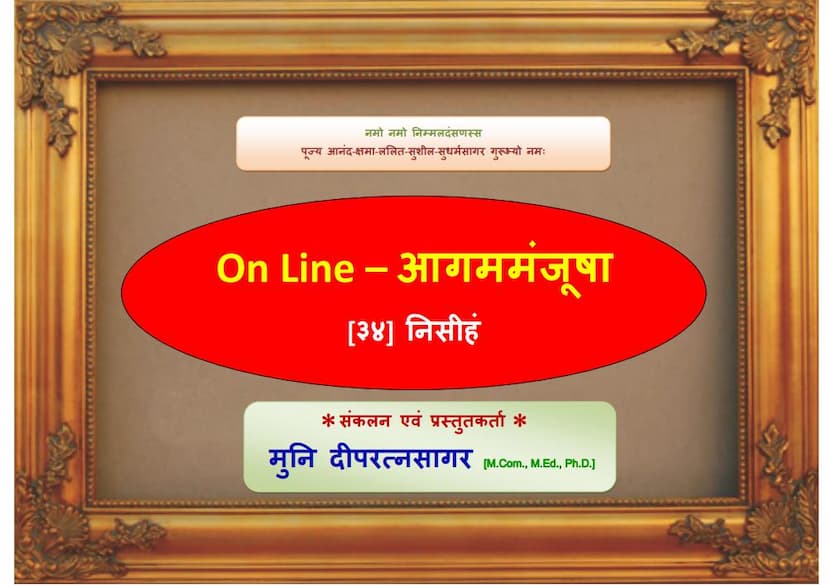Aagam Manjusha 34 Chheyasuttam Mool 01 Nisiham
Added to library: September 1, 2025

Summary
This document is a Jain text titled "Aagam Manjusha 34 Chheyasuttam Mool 01 Nisiham," compiled and presented by Muni Deepratnasagar. The text itself is a detailed exposition of rules and prohibitions for Jain monks and nuns, presented in Prakrit script.
Here's a breakdown of the key information and content:
Book Details:
- Title: Aagam Manjusha 34 Chheyasuttam Mool 01 Nisiham
- Authors/Compilers: Anandsagarsuri, Sagaranandsuri (mentioned as earlier editors/authors), Muni Deepratnasagar (current compiler and presenter).
- Publisher: Deepratnasagar
- Catalog Link: https://jainqq.org/explore/003934/1
- Presentation: The text is being presented "OnLine" after 70 years, with some modifications compared to the original edition from 1942 (Veer Samvat 2468).
Introduction (Page 2):
- The editor, Muni Deepratnasagar, explains that the original "Aagam Manjusha" was compiled 70 years prior by Acharya Shri Anand Sagar Suriji.
- This new online edition aims to make the sacred texts accessible through the internet, incorporating useful changes.
- Specific Changes/Inclusions:
- Aavashyak Sutra (Aagam-40) now includes not only the root verses but also the Niyukti (commentary/explanation).
- Jeetkalpa Sutra (Aagam-38) includes the root verses and the Bhashya (further commentary).
- An alternative scripture for Jeetkalpa Sutra, "Panchakalpa," with its Bhashya, is included.
- "Oghniyuki" (Aagam-41) includes its alternative scripture, "Pindanuyukti," though its printing location might differ.
- "Kalpa (Barasa) Sutra" has also been included in this edition.
Core Content (Nisiham Sutra):
The bulk of the document (Pages 3-14) consists of the actual "Nisiham Sutra" written in Prakrit. This section is a detailed list of offenses or breaches of conduct for Jain ascetics, each followed by a reference number (likely to specific verses or sections within the larger text). The nature of these offenses covers a wide range of activities:
- Physical Actions:
- Engaging in physical labor or directing others to do so (e.g., cutting, digging, collecting).
- Self-care activities like massaging, applying oils or powders, bathing, cleaning ears, nails, etc., with specific prohibitions on how and when these can be done.
- Using tools for cleaning or grooming.
- Wearing or using certain types of clothing or materials.
- Activities related to walking, sitting, sleeping, and staying in specific places.
- Dietary and Consumption Rules:
- Prohibitions related to accepting or consuming food and drinks, with strict rules about the source, preparation, and conditions of consumption.
- Rules about sharing food, accepting alms, and avoiding specific types of food (e.g., that which is mixed, impure, or offered by householders under certain circumstances).
- Rules about how food should be prepared or received.
- Rules Related to Possessions and Equipment:
- Prohibitions on the use, modification, or improper handling of ascetic equipment (e.g., bowls, cloths, broom, water pots, needles).
- Rules about maintaining and using items.
- Rules Related to Daily Conduct and Behavior:
- Prohibitions on activities like scratching, applying substances to the body, wearing certain garments.
- Rules about disposing of bodily waste and cleaning oneself.
- Prohibitions on cutting or shaping nails, hair, or anything else.
- Rules about accepting alms from different types of people or places, and the conditions under which it is permissible or prohibited.
- Rules about preparing or using specific materials for cleaning or comfort.
- Rules Regarding Interaction with the Outside World:
- Prohibitions on interacting with householders or outsiders in certain ways or under certain conditions.
- Rules about entering or leaving specific places (houses, villages, forests, etc.).
- Prohibitions on touching or handling certain objects or materials obtained from laypeople.
- Rules about dealing with specific individuals or groups (e.g., royalty, guards, women, different castes).
- Rules about activities related to the king's court, warfare, or administration.
- Specific Prohibitions for Monks and Nuns:
- The text details numerous specific actions that are considered breaches of monastic discipline, often referred to as "Savadh" or "Pratyakhyaan" (prohibitions).
- Many of these are presented as a list of "Ye Bhikkhu..." (If a monk...) followed by the prohibited action and a reference number.
- There are also specific sections addressing violations related to specific situations like illness, travel, or interaction with other religious practitioners.
- There are repeated mentions of "मासिकं परिहारस्थानं उग्घाडयं" (monthly period of expiation/punishment) or similar terms, indicating consequences for breaking the rules.
- The text is divided into sections called "Uddeshaka" (chapters/sections), with specific verses or points numbered within each.
Key Themes and Concepts:
- Ahimsa (Non-violence): Many rules are aimed at preventing harm to living beings, whether directly or indirectly. This includes prohibitions on harming plants, soil, water, and animals.
- Brahmacharya (Celibacy and Control of Senses): A significant portion of the text deals with strict rules regarding sensual indulgence, physical contact, and inappropriate interactions, especially with the opposite sex.
- Aparigraha (Non-possession): Rules related to the use and ownership of ascetic implements and clothing reflect the principle of non-possession.
- Tapas (Austerity): The detailed rules on diet, behavior, and self-discipline are all part of the ascetic practices aimed at spiritual purification.
- Discipline and Conduct: The Nisiham Sutra is fundamentally a code of conduct for Jain ascetics, outlining their daily life and the strict adherence to principles required for spiritual progress.
Overall Purpose:
The "Nisiham Sutra" is a crucial text in Jainism, particularly for the monastic order. It serves as a guide to maintain the highest standards of conduct and purity, essential for achieving liberation (moksha). The meticulous detail in listing prohibited actions underscores the Jain emphasis on intentionality and awareness in all activities, aiming to minimize harm and cultivate spiritual discipline. The modern online presentation by Muni Deepratnasagar signifies an effort to preserve and disseminate this important scripture in the digital age.